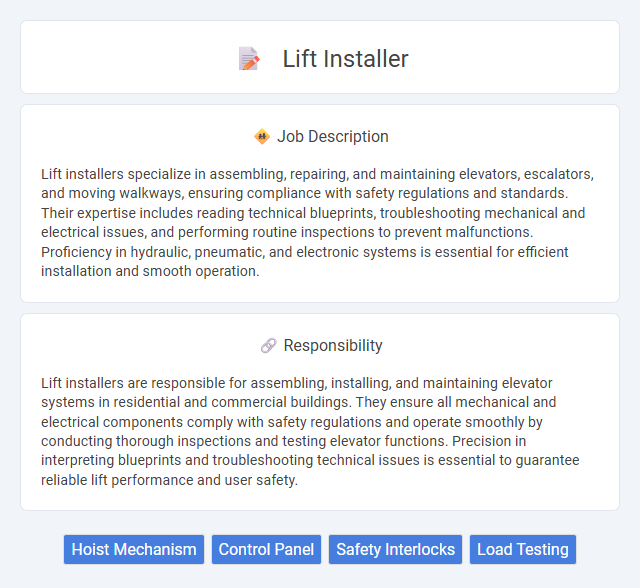
Lift installers specialize in assembling, repairing, and maintaining elevators, escalators, and moving walkways, ensuring compliance with safety regulations and standards. Their expertise includes reading technical blueprints, troubleshooting mechanical and electrical issues, and performing routine inspections to prevent malfunctions. Proficiency in hydraulic, pneumatic, and electronic systems is essential for efficient installation and smooth operation.
Individuals with good physical fitness and strong problem-solving skills are likely to be suitable for a lift installer job. People who can comfortably work in confined spaces and handle heavy equipment may have a higher probability of success in this role. Those with a fear of heights or poor hand-eye coordination might find the job challenging and less suitable.
Qualification
Lift installers must possess technical qualifications such as a high school diploma or equivalent, coupled with specialized training in electrical and mechanical systems. Certification from recognized bodies like the National Association of Elevator Contractors (NAEC) enhances job prospects and ensures adherence to safety standards. Practical experience through apprenticeships or on-the-job training is essential for mastering installation, maintenance, and troubleshooting of elevator systems.
Responsibility
Lift installers are responsible for assembling, installing, and maintaining elevator systems in residential and commercial buildings. They ensure all mechanical and electrical components comply with safety regulations and operate smoothly by conducting thorough inspections and testing elevator functions. Precision in interpreting blueprints and troubleshooting technical issues is essential to guarantee reliable lift performance and user safety.
Benefit
Working as a lift installer probably offers strong job security due to constant demand for installation and maintenance in residential and commercial buildings. The role may provide competitive salaries and opportunities for skill development, which can lead to career advancement. Benefits likely include hands-on experience with advanced mechanical and electrical systems, enhancing technical expertise.
Challenge
Lift installer jobs likely involve complex challenges related to ensuring safety, precision, and compliance with strict building codes. Technicians may face difficulties working in confined spaces and at considerable heights, requiring both physical and mental resilience. The probability of encountering unforeseen technical issues during installation demands strong problem-solving skills and adaptability.
Career Advancement
Lift installer careers offer significant opportunities for advancement through gaining certifications such as the National Association of Elevator Contractors (NAEC) certification and mastering complex hydraulic and traction elevator systems. With experience, professionals can move into supervisory roles, project management, or specialized technical positions in elevator modernization and safety compliance. Continuous training in emerging smart elevator technologies and adherence to local safety regulations further enhances career growth and earning potential in this field.
Key Terms
Hoist Mechanism
A lift installer specializes in assembling and securing the hoist mechanism, which is crucial for the vertical movement of elevator cabins. They ensure the proper installation of ropes, pulleys, and motor systems that drive the hoist, guaranteeing safe and efficient operation. Precision in aligning the hoist components directly impacts the lift's performance and passenger safety.
Control Panel
A lift installer specializes in the precise assembly and wiring of control panels that regulate elevator operations, ensuring seamless communication between mechanical components and user commands. Mastery in interpreting electrical schematics and calibrating programmable logic controllers (PLCs) is critical to optimizing lift safety and performance. Expert control panel configuration directly impacts elevator response times, fault detection, and compliance with international safety standards such as EN 81 and ASME A17.1.
Safety Interlocks
Lift installers ensure the proper installation and calibration of safety interlocks to prevent elevator doors from opening when the lift is not at a landing, minimizing risk to passengers. They conduct rigorous testing of interlock mechanisms to maintain compliance with industry safety standards such as ASME A17.1 and EN 81. Expertise in diagnosing and repairing faulty interlocks is crucial to uphold elevator safety and functionality.
Load Testing
Load testing in lift installation ensures the safety and reliability of elevators by verifying their ability to handle specified maximum weights without malfunction. Technicians conduct systematic load tests using calibrated weights to simulate real-world conditions, confirming compliance with safety standards such as ASME A17.1 or EN 81. Proper load testing prevents mechanical failures, enhances passenger safety, and is a critical step before a lift is commissioned for public use.
 kuljobs.com
kuljobs.com